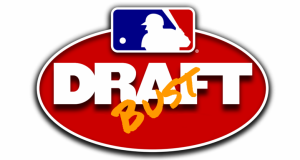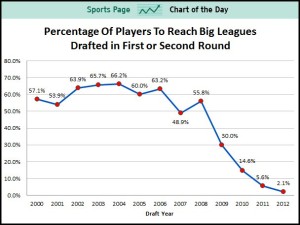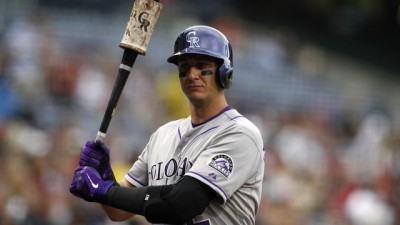Bust. It’s a term that is as frequently misused in referring to prospects as ace is to pitchers. The problem with its frequent use, is the lack of a defined quantitative structure. With that said, I am going to attempt to do define it, at the risk of digressing often and boring many I will source the data used. Merriam-Webster defines bust (n): a complete failure : flop. For this to be applicable to a baseball player, there needs to be a certain level of expectation, one of a major league contributor.
Recent successful draft picks have skewed our vision of what a productive major league player is by becoming high profile players. Comparing every player under 30 to Mike Trout is like comparing every catholic to the pope, they just won’t measure up. It’s unfair to everyone involved.
Cork Gaines at Business Insider had a fairly recent (2013) article on the length of time it takes for a first round draft pick to reach the major leagues. Using data available from the thebaseballcube.com, he surmised it takes the typical player 4-6 years to reach the major league, with the peak at 7 years after which, “approximately two-thirds of players drafted in the first round will have made it to the big leagues. But if a player has not made it by then, it is unlikely that they will ever make it”. A bust that we can all agree on.
But what of those that do reach the major leagues? To begin to define a bust we must come to a conclusion of what is not a bust, a subject unto its own. To simplify things I will utilize bWAR, another often misused and abused term, though in this case I think its simplified reference is actually applicable, (and in terms of draft research it is all together.) In defining what is not a bust we have to come to a conclusion of what is an average major league player having an average major league career.
The average career length derived from a study performed by University of Colorado at Boulder research team, lists the average major league player career at 5.6 years. Which doesn’t sound very long but is actually the longest of professional sports (parents, all the more reason to encourage baseball on your kids). Putting that into context, a player in his final typical arbitration year is at the end of average major league playing career.
Baseball-Reference.com uses the following scale for WAR values:
- 8+ MVP Quality
- 5+ All-Star Quality
- 2+ Starter
- 0-2 Reserve
- <0 Replacement Level
For us to conclude that a player will last in the league for the average major league playing career, he would have to have value, at least perform on an average of at a reserve level or better. We are going to over simplify things once again and say an average of 1.5 WAR (slightly above average WAR for a reserve) for the average playing career of 5.6 years for a career total of 8.4 bWAR (1.5*5.6=8.4). I do realize this is a flawed generalization, in that it does not take into account positions, era, or specific role for a team, because a LOOGY could play forever and yet never hit 1.5 bWAR in a single season.
Combining the average playing career with the typical developmental time, it would take about 10 years for a determination to be made as to whether or not a player is a bust. Of course if first round draft pick hasn’t lasted that long in baseball a declaration of bust is warranted, though the label would be unfair for someone whose career was derailed by injuries.
In applying the above criteria to the 48 players taken in the first round of the 2005 MLB Draft; we find 77% of players selected have reached the major leagues. They have combined to average 9.4 bWAR. The highlights of that draft include Justin Upton, Alex Gordon, Troy Tulowitzki, and Andrew McCutchen. A few that failed to reach the majors include Wade Townsend, C.J. Henry, and Beau Jones.
Then digging in and looking at the serviceable major leaguers who have a continued career and reached the arbitrarily designated 8.4 bWAR mark the list includes Cameron Maybin (9.4 bWAR), Colby Rasmus (16.1), Jed Lowrie (9.1) and Jay Bruce (15.1). Those who reached the majors yet their careers did not measure up include former Mets Garrett Olson, Lance Broadway, John Mayberry Jr, and one time highly touted prospect Jeff Clement.
The list of players that have reached the 5.6 years of service time yet have not reached the bWAR mark include nemesis Luke Hochevar (7.151 years, and a 2.8 bWAR), and former Met Mike Pelfrey (8.122 & 6.0). Pelfrey should reach that mark within the next 2-3 years, and while Hochevar was a bust as a starter, but he has been as we all know, an integral part of the Royals bullpen. So despite the bad taste left in our mouths from the Mets 2011 opening day starter, Pelfrey’s career has not been a bust.
So what to do with all this information? The next time someone claims Brandon Nimmo is a bust, remind them that he is on track to reach the majors on schedule, and it will take a few years of playing to make such a declaration. In the meantime we should temper our expectations, let the players develop as they should, and remind them of Robert Stratton.




